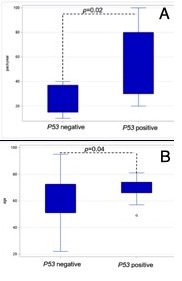Abstract
Background: Inflammation and aging are factors associated with mutagenicity. In acute Myelogenous Leukemia (AML), detectable mutations (mut) are a powerful tool for identification of patients (pt) at a higher risk for relapse. One frequently observed mutation is TP53, which is particularly unresponsive to treatment. Known risk factors for TP53 acquisition include prior chemotherapy or radiation exposure. It is possible that TP53 mut initiates at low allele frequency and expands in a "permissible marrow microenvironment". Cell extrinsic inflammation, collectively called extracellular stressor, is a theory of mutation acquisition which is gaining momentum given its recently recognized role in clonal initiation, expansion, and dominance. Smoking is one such possible extracellular stressor that dramatically increases risk of human cancer. Lung tissue directly exposed to smoking develops higher frequency of mut; however, other tissue not directly exposed (e.g. bladder, pancreas) exhibit similar mutation frequencies. This suggests that active smoking metabolites systemically induce inflammation and/or mutagenicity. Indeed, TP53 and ASXL1 mut have been associated with clonal hematopoiesis (CH). In this study, we seek to create "proof of clinical concept" for association between smoking "dose" and TP53 myeloid malignancy development when controlled by an age-adjusted effect. Methods: After IRB approval, AML and Myelodysplastic Syndrome (MDS) AML patients with available Next Generation Sequencing (NGS) were isolated from MDS/AML databases. "Smoking dose" was estimated in patients exhibiting or not exhibiting TP53 mut by standard pack-year calculation. Demographics, clinical, and laboratory categorical and continuous variables were analyzed by chi-square and t-test using SAS software. Logistic regression analysis allowed for identification of variables with independent predictive value for TP53 acquisition. Results: Our cohort represented 52 patients (pt) [AML N=47/52 (90.3%) and MDS N=5/52 (9.6%)]. 23/52 (44.2%) pt harbored TP53-mut and 29/52 pt (55.8%) were part of a genomic control group harboring ASXL1, RUNX1, FLT3, NPM1, and KRAS mut. Median age for pt with and without TP53 mut was 71 y (49-81) vs 60 y (22-88), respectively, p= 0.04 [Fig. 1B]. In TP53 mutated vs TP53 unmutated group, 14/23 (60.8%) vs 13/20 (65%) pt were male. 9/23 (39.1%) and 7/20 (35%) of pt with and without TP53 mut had available smoking history. Pack-year smoking was 53.6 [20-100] and 23.2 [10-40], in pt wit and without TP53 mut, respectively, p=0.02 [Fig. 1A]. When adjusted by age and prior chemotherapy exposure, smoking dose density was the only potential factor with relevance for TP53 acquisition (p=0.05). Conclusions: In myeloid malignancies, our data suggests that TP53 acquisition is associated with a dose dependent smoking history. This smoking dose dependency seems to be independent from aging and prior chemotherapy exposure in AML. Previous studies have demonstrated strong associations between smoking and inflammation. It is possible that higher dosages of smoking induce marrow microenvironment inflammatory changes permissible for TP53 initiation. These microenvironmental changes may be associated with mutational signatures similar to those found in other smoking-associated malignancies, including lung adenocarcinoma. Our report adds to the body of evidence for mechanistic link between magnitude of smoking exposure and marrow environmental stress to promote selective mutagenicity, though larger study is needed.
No relevant conflicts of interest to declare.


This feature is available to Subscribers Only
Sign In or Create an Account Close Modal